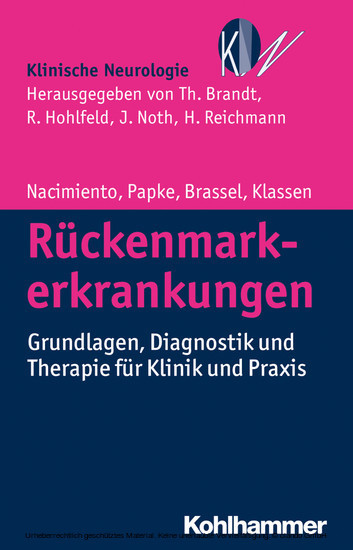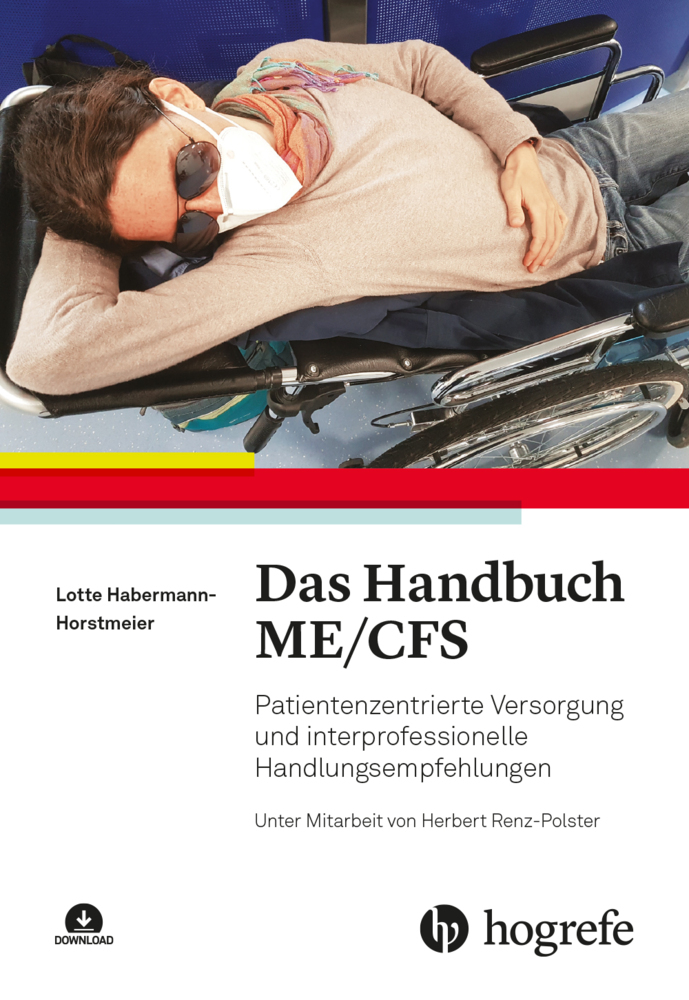Rückenmarkerkrankungen
Grundlagen, Diagnostik und Therapie für Klinik und Praxis
Spinal cord diseases play an important role in regards to neurologic and neurosurgical practices. Advances in regards to the diagnostics and laboratory research have improved the recognition of these clinical pictures. This book emphasises the significance of thorough medical history enquiries and clinical examinations. It unlocks the use of technical and laboratory-diagnostic additional examinations, which results in differential-diagnostic and therapeutic concepts for clinical pictures. Case histories are used to describe problems and possible solutions.
Prof. Dr. Wilhelm Nacimiento (Clinic for Neurology and Early Neurologic Rehabilitation) & Prof. Dr. Friedhelm Brassel (Clinic for Neuroradiology and Radiology), Hospital in Duisburg Dr. Karsten Papke (Clinic for Radiology and Neuroradiology) & Dr. Peter Douglas Klassen (Clinic for Spinal Surgery and Neurotraumatology), St. Bonifatius-Hospital Lingen.
Prof. Dr. Wilhelm Nacimiento (Clinic for Neurology and Early Neurologic Rehabilitation) & Prof. Dr. Friedhelm Brassel (Clinic for Neuroradiology and Radiology), Hospital in Duisburg Dr. Karsten Papke (Clinic for Radiology and Neuroradiology) & Dr. Peter Douglas Klassen (Clinic for Spinal Surgery and Neurotraumatology), St. Bonifatius-Hospital Lingen.
1;Deckblatt;1 2;Titelseite;5 3;Impressum;6 4;Inhaltsverzeichnis;7 5;Vorwort;15 6;Geleitwort;17 7;1 Allgemeiner Teil;19 7.1;1.1 Neuroanatomische Grundlagen;19 7.1.1;1.1.1 Einleitung;19 7.1.2;1.1.2 Propriospinale Systeme;20 7.1.3;1.1.3 Aszendierende Bahnen;21 7.1.3.1;1.1.3.1 Tractus spinothalamicus lateralis (Schmerz und Temperatur);21 7.1.3.2;1.1.3.2 Fasciculi cuneatus und gracilis (Berührung, Vibration, Lageempfindung und Zweipunktdiskrimination);21 7.1.3.3;1.1.3.3 Tractus spinocerebellaris posterior (Propriozeption);22 7.1.4;1.1.4 Deszendierende Bahnen;22 7.1.4.1;1.1.4.1 Tractus corticospinalis;23 7.1.4.2;1.1.4.2 Extrapyramidale Bahnen;24 7.1.5;1.1.5 Vegetatives spinales System;24 7.1.5.1;1.1.5.1 Sympathicus;26 7.1.5.2;1.1.5.2 Parasympathicus;26 7.1.6;1.1.6 Gefäßversorgung des Rückenmarks;26 7.1.6.1;1.1.6.1 Arterielle Gefäßversorgung: Überblick;26 7.1.6.2;1.1.6.2 Embryologie und Zuflüsse der Rückenmarksarterien;28 7.1.6.3;1.1.6.3 Venöse Drainage;29 7.2;Literatur;29 7.3;1.2 Spinale Syndrome;30 7.3.1;1.2.1 Klinik und Verlauf;30 7.3.2;1.2.2 Akutes Querschnittsyndrom;30 7.3.3;1.2.3 Chronisches Querschnittsyndrom;31 7.3.4;1.2.4 Autonome Dysreflexie;32 7.4;Literatur;33 7.5;1.3 Spezifische Querschnittsyndrome in Abhängigkeit von der Lokalisation und Ausdehnung der Rückenmarksläsion;33 7.5.1;1.3.1 Definition der Querschnittslähmung;33 7.5.2;1.3.2 Läsionen des Zervikalmarks;34 7.5.3;1.3.3 Läsionen des Thorakalmarks;34 7.5.4;1.3.4 Läsionen des Lumbalmarks, des Conus medullaris und der Cauda equina;35 7.5.5;1.3.5 Brown-Séquard-Syndrom;35 7.5.6;1.3.6 Zentromedulläres Syndrom;36 7.5.7;1.3.7 Ursachen spinaler Läsionen;36 7.6;1.4 Pathophysiologie der akuten Rückenmarksverletzung;39 7.6.1;1.4.1 Zelluläre Reaktionen nach Rückenmarksverletzung;39 7.6.2;1.4.2 Reorganisation motorischer Systeme nach Rückenmarksverletzung;40 7.6.3;1.4.3 Klinische Perspektiven der paraplegiologischen Forschung;41 7.7;Literatur;41 7.8;1.5 Zentraler neuropathischer Schmerz bei Myelonläsion;42 7.9;Literatur;44 8;2 Diagnostik;45 8.1;2.1 Klinisch-neurologische Untersuchungsverfahren;45 8.1.1;2.1.1 Anamnese und körperliche Untersuchung;45 8.1.2;2.1.2 Klinisch-neurophysiologische Untersuchungsmethoden;45 8.1.3;2.1.3 Klinische Neurophysiologie in der Paraplegiologie;46 8.1.3.1;2.1.3.1 Somatosensibel und motorisch evozierte Potenziale (SEP, MEP);46 8.1.3.2;2.1.3.2 Somatosensorisch evozierte Potenziale;46 8.1.3.3;2.1.3.3 Motorisch-evozierte Potenziale;47 8.1.3.4;2.1.3.4 Elektroneuro- und -myografie;47 8.1.3.5;2.1.3.5 Neurophysiologische Diagnostik der Blasenfunktion;47 8.1.4;2.1.4 Liquordiagnostik;48 8.1.5;2.1.5 Skalierung klinischer Defizite;49 8.2;Literatur;50 8.3;2.2 Neuroradiologische Untersuchungsmethoden;51 8.3.1;2.2.1 Stellenwert der Bildgebung in der Diagnostik spinaler Erkrankungen;51 8.3.2;2.2.2 Konventionelle Röntgenaufnahmen;52 8.3.3;2.2.3 Computertomografie;52 8.3.4;2.2.4 Magnetresonanztomografie;53 8.3.4.1;2.2.4.1 Prinzip;53 8.3.4.2;2.2.4.2 Stellenwert in der Bildgebung von Rückenmarkerkrankungen;56 8.3.5;2.2.5 Myelografie;56 8.3.5.1;2.2.5.1 Technik und Durchführung;56 8.3.5.2;2.2.5.2 Aussagekraft und Indikationen;57 8.3.5.3;2.2.5.3 Postmyelografische Computertomografie;58 8.3.6;2.2.6 Digitale Subtraktionsangiografie;58 8.3.7;2.2.7 CT-Angiografie;59 8.3.8;2.2.8 MR-Angiografie;60 8.3.8.1;2.2.8.1 Time-of-Flight-(TOF)-MRA;60 8.3.8.2;2.2.8.2 Kontrastmittelverstärkte MR-Angiografie;60 8.3.9;2.2.9 Multimodale spinale Bildgebung: MRT, dynamische MRA und spinale DSA;61 8.3.9.1;2.2.9.1 Fallbeispiel;61 8.3.9.2;2.2.9.2 Fazit;63 8.4;Literatur;66 9;3 Spezieller Teil (nach Ätiologie geordnet);67 9.1;3.1 Das spinale Trauma;67 9.1.1;3.1.1 Pathophysiologie der Rückenmarksverletzung;67 9.1.2;3.1.2 Prognostische Einschätzung;70 9.1.3;3.1.3 Therapie des spinalen Traumas;70 9.2;Literatur;70 9.3;3.2 Fehlbildungen von Wirbelsäule und Rückenmark;71 9.3.1;3.2.1 Neuralrohrdefekte;71 9.3.1.1;3.2.1.1 Spina bifida aperta (Myelomeningozele, MMC);72 9.3.1.2;3.2.1.2 Spina bifida occulta (Okk
Nacimiento, Wilhelm
Papke, Karsten
Brassel, Friedhelm
Klassen, Peter-Douglas
| ISBN | 9783170250468 |
|---|---|
| Article number | 9783170250468 |
| Media type | eBook - ePUB |
| Copyright year | 2014 |
| Publisher | Kohlhammer Verlag |
| Length | 202 pages |
| Language | German |
| Copy protection | Digital watermarking |










